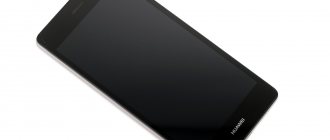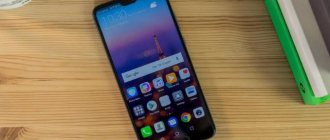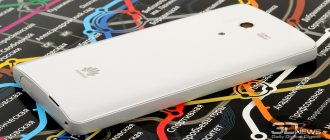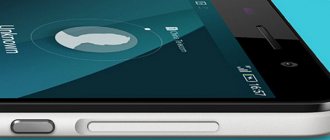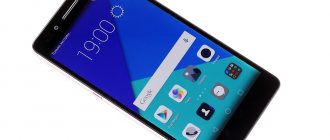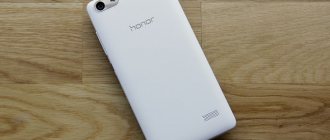We need more cameras in a smartphone, good and different - two are not enough, so they added a third. Design? The trend of the season is the unibrow, also known as bangs. Yes, yes, about the same as that apple company. But is this bad? There may be only one idea, but it’s all about the implementation, and, looking ahead, let’s say that the implementation in this case did not let us down. Recently, Huawei announced a line of new frameless smartphones, among which there are devices in three price ranges, but very similar in concept and design. The difference is in the details and internal filling.
Today our editors will introduce you to the new flagship smartphone Huawei P20 Pro. What it has in common with the previous generation, Huawei P10, is the presence of advanced photo capabilities, including a separate black-and-white photo module created in partnership with Leica.
Specifications
- Screen: 6.1″, OLED, 1080 x 2240, 408 ppi;
- Processor: Huawei Kirin 970, 8 cores, up to 2.4 GHz;
- Operating system: Android OS 8.0;
- RAM: 6 GB;
- Built-in memory: 128 GB;
- Memory card support: no;
- Communication: GSM 850/900/1800/1900 MHz || UMTS 850/900/1900/2100 MHz || LTE TD-LTE: 34, 38, 39, 40, 41. LTE FDD: 1 - 9, 12, 17 - 20, 26, 28;
- SIM: 2 x nano-SIM;
- Interfaces: Wi-Fi 802.11 a/b/g/n/ac (2.4/5 GHz), Wi-Fi Direct, Bluetooth 4.2 BLE, NFC, USB Type-C;
- Navigation: GPS, GLONASS, Galileo, Beidou;
- Cameras: main – 40 MP + 20 MP + 8 MP, front – 24 MP;
- Battery: 4000 mAh;
- Package contents: phone, USB-C headphones, charger, USB-C cable, USB-C to 3.5 mm headphone jack adapter, transparent case, quick start guide, SIM card removal tool, warranty card;
- Dimensions: 73.9x155x7.8 mm;
- Weight: 180 grams.
Appearance
In the new generation of Huawei smartphones, they abandoned the Plus prefix in the name, and it’s difficult to call a Plus smartphone, the size of which, despite the 6.1-inch diagonal, is not much larger than the 5.2-inch smartphones of previous years. Due to the frameless screen, the company was able to significantly reduce the dimensions.
The screen is the main new design element. Almost the entire front side of the smartphone is occupied by a large 6.1-inch OLED screen. Thin frames, a small strip under the screen with a fingerprint scanner located in it, which can also act as a control button. The upper part of the screen is almost close to the borders of the smartphone, with the exception of a small part in the middle, which houses the proximity and light sensors, the earpiece and the front camera. It is this protrusion that is usually called either a bang or a unibrow.
By the way, pay attention to the corners of the screen, the screen itself, and not the smartphone - they are slightly rounded, which gives the screen a very pleasant and unusual appearance.
Looking ahead, let's say that you can hide the above-mentioned unibrow (in the manufacturer's terms this is called a “controller”). In the screen settings, you can select an option in which service statuses will simply be displayed on the bars to the right and left of this controller, and the bar itself will turn black. This allows you to save useful screen area by displaying all network statuses, wi-fi, battery charge, etc. in these areas. It is in this mode that it is most pleasant to work with the phone, and it looks nicer than just a smartphone with a cutout in the screen.
There are three cameras on the reverse side. The main one is 40 MP with an RGB sensor, the additional one is 20 MP with a b/w sensor, and the third is an 8 MP camera with a telephoto lens that allows you to create some kind of optical zoom. But we'll talk about the cameras themselves later. Below them is a flash and the proud inscription LEICA. There is also additional information about the focal length of the camera; when converted to EGF, it turns out to be 27-80 mm (three times zoom), at 27 mm the aperture is f/1.6, and at the telephoto range it is 70 mm at f/2.4. The back of the smartphone is made of tempered glass, under which The housing is blue. Also, Huawei P20 Pro is presented in black and a very interesting color option, called Master AI (professional photo assistant). Master AI determines what exactly you are photographing, what the scene is, and, based on this, sets the preset camera settings. Moreover, it determines quickly and accurately. Point the camera at a cat - the cat message pops up and the program adapts to shooting animals; portrait mode is determined in the same way, for example, shooting food, flowers, landscapes, etc. We must pay tribute to this assistant - the pictures really turn out to be of higher quality and more interesting.
ISO test
ISO 400
ISO 800
ISO 1600
ISO 3200
ISO 6400
For a smartphone camera, the result is simply excellent. Thanks to this, as well as an improved image processing algorithm, the camera is able to shoot even at night. The “night shooting” mode allows you to increase sensitivity to ISO 102400, but this is achieved through software - the smartphone takes several pictures, then combines them into one using a special algorithm to reduce noise and increase detail. The idea of such a solution is not new, but we have not previously encountered its use in smartphones.
Sample pictures
Panorama mode
Wide aperture mode
When this mode is turned on programmatically, the effect of a shallow depth of field is achieved, and you can also change the focus point and depth of field on already captured photographs. The aperture range is listed as f/0.95 to f/16 equivalent. The aperture value can be set both during shooting and after. You can also change the focus point after shooting. In addition, you can not only blur the background, but also apply one of the available filters to it. The principle remains the same - everything that is not included in the depth of field changes, but the subject itself remains unchanged.
The mode works both for color photographs and in monochrome mode. Most photos are pleasing to the eye, with just the right amount of blur, but too low an aperture can make the image look unrealistic; too much and harsh blur looks sloppy and turns the viewer off. Therefore, this mode must be used carefully, choosing the right angle and blur strength.
Monochrome mode
Monochrome mode was one of the main features of the Huawei P10, and remains so in the Huawei P20 PRO. A regular color sensor contains special light filters that cut off part of the transmitted light, but with further processing and interpolation it allows you to collect a color image. But if these filters are removed, we will only get the brightness component of the picture. This allows you to increase photosensitivity and expand the dynamic range of the image. But, naturally, at the output we will get a black and white image.
In the world of large cameras, there is only one modern camera with a monochrome sensor - the Leica M Monochrom. The solution is highly specialized and expensive. You can have different attitudes towards black and white photography, but in certain situations, black and white photographs look more advantageous than color ones.
Huawei P20 PRO allows you to take black and white photos in resolutions of up to 20 MP (you can also select 10 and 7 MP in the settings). The result is excellent, detailed images with an acceptable noise level even at high ISOs.
Video recording
The maximum video resolution is 4K @30 fps, Full HD is available at 60 fps, and 30 fps. Separately, in the camera menu, you can select the “Slow motion” item, which has several options for shooting slow motion video:
- 32x – shooting HD video at 960 frames per second, which with standard playback allows you to slow down the image 32 times, but with a significant limitation: it must be light enough to provide such a short shutter speed for individual frames, and shooting takes only a quarter of a second.
- 4x and 8x – slowdown by 4 and 8 times, respectively, shooting in fullHD without a limitation on shooting time.
The optical stabilizer in video shooting mode only works in Full HD @30 fps mode and in lower quality modes. There are no complaints about video shooting - focusing is confident, there are no jerks, the picture is bright and detailed.
Front-camera
The front 24-megapixel camera with autofocus and f/1.9 aperture keeps up with the high quality bar set by the main camera block. Photos are obtained with a good level of detail, the picture is clear and rich. The only unpleasant moment is the photo “beautification” mode; the smartphone tries to smooth out skin imperfections, which sometimes negatively affects the picture. Moreover, despite the fact that the setting of this function is set to zero, the effect of improving the skin still remains noticeable.
Photo modes
I have already touched a little on the modes that the camera offers. In this section I would like to talk in more detail about most of them and show photographs.
In almost all modes, you can select the film type “Normal”, “Bright”, “Faded”.
Huawei P20 Pro, Regular film. © Photar.ru
Huawei P20 Pro, Bright film. © Photar.ru
Huawei P20 Pro, Faded film. © Photar.ru
Photo mode
The main operating mode for many will of course be “Photo”. If you don’t want to “bother” at all, then this mode is created for you :) The phone is able to determine the scene and suggest a scenario. So, for example, if you are shooting grass or trees, then the AI will offer the “Green” scenario, and if the sky, then “Sky”. If it is a portrait, then the background will be blurred, and the script will be called “Portrait”, etc.
Huawei P20 Pro, shutter speed 1/895s, ISO100, f/1.8, 27mm equiv. focal length. “Photo” mode, 10MP. © Photar.ru
Huawei P20 Pro, shutter speed 1/1600s, ISO50, f/1.8, 27mm equiv. focal length. “Photo” mode, 40MP. © Photar.ru
Huawei P20 Pro, shutter speed 1/50s, ISO80, f/1.8, 27mm equiv. focal length. “Photo” mode, 40MP. © Photar.ru
Huawei P20 Pro, shutter speed 1/900s, ISO100, f/1.8, 27mm equiv. focal length. “Photo” mode, 40MP. © Photar.ru
Huawei P20 Pro, shutter speed 1/895s, ISO320, f/1.8, 27mm equiv. focal length. “Photo” mode, 10MP. © Photar.ru
Huawei P20 Pro, shutter speed 1/270s, ISO50, f/2.4, 81mm equiv. focal length. “Photo” mode, 10MP. © Photar.ru
When the AI selects a scenario, it informs about this on the screen; if desired, you can disable the proposed scenario by clicking on the cross. Why might this be needed? For example, here are two pictures, in the first the AI made a mistake, in the second I turned off the proposed script and the photo turned out better.
Huawei P20 Pro, Photo mode, AI enabled. Computers make mistakes too;) © Photar.ru
Huawei P20 Pro, Photo mode with AI disabled. © Photar.ru
The artificial intelligence module is capable of offering more than 500 scenarios and recognizing 19 scenes. If a script is selected, the film type cannot be changed.
Some scripts have a more advanced option. For example, like for the “Food” scene. There is a separate mode called “Delicious food”. I didn’t notice any difference in the “Photo” mode with the “Food” scenario and the “Tasty Food” mode. The food looks “delicious” both here and there. Maybe you can do it:
For example, like for the “Food” scene. There is a separate mode called “Delicious food”. I didn’t notice any difference in the “Photo” mode with the “Food” scenario and the “Tasty Food” mode. The food looks “delicious” both here and there. Maybe you can do it:
“Delicious food” mode. © Photar.ru
“Photo” mode, “Food” scenario. © Photar.ru
Pro mode
Here you can manually adjust ISO, shutter speed, set exposure compensation and white balance. And, as I already said, only in this mode is it possible to save files in RAW format. Well, why not a Pro, right?)
When working in 10MP resolution or any other lower resolution with the “Save RAW” option selected, the phone will save a jpg file in the selected resolution and a RAW file with a resolution of 40MP into memory; by the way, the weight of such a file is as much as 79.9 megabytes. So even 128GB of internal memory, which is a lot, can run out very quickly. When saving in RAW, the user does not have access to zoom.
On the issue of working with RAW. Yes, the camera saves 40-megapixel raw files and you can actually use a RAW editor. Shadows, highlights, exposure are all editable; you can increase the exposure to more or less 2-3 stops before noise appears, which is a very good indicator for this matrix size. But let’s see with our own eyes what kind of work the AI does and understand whether it’s worth bothering with RAW editing at all. Let’s compare the “raw” file without processing with the result of AI processing.
Huawei P20 Pro, shutter speed 1/2000s, ISO50, f/1.8, 27mm equiv. focal length. "Pro" mode. The first is RAW without processing (Source), the second is with AI processing (Source). © Photar.ru
Huawei P20 Pro, shutter speed 1/2430s, ISO50, f/1.8, 27mm equiv. focal length. "Pro" mode. The first is RAW without processing (Source), the second is with AI processing (Source). © Photar.ru
As you can see, AI corrects not only colors, stretches shadows and highlights, but also corrects geometric distortions and vignetting. In most cases, achieving better results by manually editing RAW will be difficult and time consuming.
“Pro” or “Photo”?
If you compare the Photo modes and the Pro mode, it is obvious that the first one often takes better-looking photos. In the “Photo” mode, the colors are saturated, but the photos do not always win in terms of dynamic range, and sometimes even the colors are too much, so to speak, oversaturation.
Portrait mode
Portrait mode is probably the most advertised feature by Huawei marketers. Indeed, in addition to simulating various types of lighting (soft flash, butterfly flash, split flash, staged lighting, normal flash), the camera is able to very quickly recognize and focus on faces, as well as beautifully blur the background.
Huawei P20 Pro, shutter speed 1/255s, ISO50, f/2.4, 81mm equiv. focal length. Portrait mode. (Source) © Photar.ru
Huawei P20 Pro, shutter speed 1/1250s, ISO50, f/2.4, 81mm equiv. focal length. Portrait mode. (Source) © Photar.ru
Huawei P20 Pro, shutter speed 1/815s, ISO50, f/2.4, 81mm equiv. focal length. Portrait mode. (Source) © Photar.ru
Huawei P20 Pro, shutter speed 1/235s, ISO50, f/2.4, 81mm equiv. focal length. Portrait mode. (Source) © Photar.ru
Combined with a 3x or 5x zoom, you can create very interesting portraits of people on the street without invading their personal space. At 3x zoom you can get portraits with an equivalent focal length of 81mm, which is very close to the 85mm favored by portrait photographers. Among other things, you can adjust the degree of the effect on a scale from 1 to 10 and enable/disable background blur.
I note that the pictures are not always of good quality. In the process of “blurring” the background, sometimes the subject you are shooting will end up with very ugly torn edges.
Huawei P20 Pro, shutter speed 1/1055s, ISO50, f/2.4, 81mm equiv. focal length. Portrait mode. (Source) © Photar.ru
Aperture mode
In this mode, you can blur the background by adjusting the aperture values from 0.95 to 16; of course, all this happens at the software level; there is no variable aperture in the lenses. Pictures taken in this mode can later be changed - the degree of blur and even the focus point.
f/0.95
Huawei P20 Pro, shutter speed 1/110s, ISO50, f/0.95, 27mm equiv. focal length. Aperture mode. © Photar.ru
f/16
Huawei P20 Pro, shutter speed 1/115s, ISO50, f/16, 27mm equiv. focal length. Aperture mode. © Photar.ru
If you compare the background blur in "Aperture" with the simple "Photo" mode. Then I would choose “Photo”, it produces a more natural and beautiful bokeh. Here is one example for comparison, judge for yourself.
"Diaphragm":
Huawei P20 Pro, shutter speed 1/1300s, ISO50, f/0.95, 27mm equiv. focal length. Aperture mode. © Photar.ru
"Photo":
Huawei P20 Pro, shutter speed 1/1180s, ISO50, f/1.8, 27mm equiv. focal length. Photo mode. © Photar.ru
Night mode
The full power of the Leica Vario-Summilux-H1 F1.6-2.4 27-80mm ASPH system is revealed in this mode. And it really surprises! The camera is capable of creating images in the evening with incredible detail, and shooting can be done handheld, and the shutter speed sometimes reaches 6 seconds.
Huawei P20 Pro, shutter speed 4s, ISO400, f/1.8, 27mm equiv. focal length. Night mode. © Photar.ru
Huawei P20 Pro, shutter speed 1s, ISO1250, f/1.8, 27mm equiv. focal length. Night mode. © Photar.ru
Such results are obtained not only due to high ISO. The camera processes the dark areas of the frame, while at the same time the light areas (lanterns or headlights) are not overexposed. Usually, with a long shutter speed, especially when shooting handheld, a “stir” appears; if cars pass in the frame, they will be blurred. In this mode, there is no such blur, the system fixes objects in place, including headlights, lanterns, and even if there is a strong tremor in the hands, the stabilizer completely neutralizes this.
Below, for the sake of experiment, are photos in “Night” and “Pro” modes with a shutter speed of 10 seconds (the smartphone is mounted on a tripod).
"Night":
Huawei P20 Pro, shutter speed 4s, ISO2000, f/1.8, 27mm equiv. focal length. Night mode. © Photar.ru
"Pro":
Huawei P20 Pro, shutter speed 10s, ISO50, f/1.8, 27mm equiv. focal length. "Pro" mode. © Photar.ru
Night mode can be used not only at night or in the dark. Very unexpected effects are created in non-standard situations for this mode. For example, in bright backlight you can get a very interesting result.
Huawei P20 Pro, shutter speed 3s, ISO50, f/1.8, 27mm equiv. focal length. Night mode. © Photar.ru
Huawei P20 Pro, shutter speed 3s, ISO50, f/1.8, 27mm equiv. focal length. Night mode. © Photar.ru
"Monochrome"
I liked this mode the most, especially for creating portraits. It has three operating modes: Normal, Aperture, Portrait and Pro. The familiar names for monochrome modes work just like their color counterparts. When I showed the results of the zoom for the “monochrome” mode above, I said that the resolution of this mode is 20 megapixels. In addition, there is no option to save files in RAW format.
Huawei P20 Pro, shutter speed 1/345s, ISO50, f/1.6, 81mm equiv. focal length. Monochrome mode. © Photar.ru
Huawei P20 Pro, shutter speed 1/2390s, ISO50, f/1.6, 27mm equiv. focal length. Monochrome mode. © Photar.ru
Huawei P20 Pro, shutter speed 1/780s, ISO50, f/1.6, 81mm equiv. focal length. Monochrome mode. © Photar.ru
Huawei P20 Pro, shutter speed 1/695s, ISO50, f/1.6, 27mm equiv. focal length. Monochrome mode. © Photar.ru
Huawei P20 Pro, shutter speed 1/6750s, ISO50, f/1.6, 81mm equiv. focal length. Monochrome mode. © Photar.ru
Huawei P20 Pro, shutter speed 1/1840s, ISO50, f/1.6, 81mm equiv. focal length. Monochrome mode. © Photar.ru
Huawei P20 Pro, shutter speed 1/2190s, ISO50, f/1.6, 27mm equiv. focal length. Monochrome mode. © Photar.ru
Huawei P20 Pro, shutter speed 1/2290s, ISO50, f/1.6, 27mm equiv. focal length. Monochrome mode. © Photar.ru
Huawei P20 Pro, shutter speed 1/3130s, ISO50, f/1.6, 81mm equiv. focal length. Monochrome mode. © Photar.ru
Video
And of course the camera is capable of recording video;) There are 5 different resolutions. Highest 4K. But the stabilizer will not work in it.
FHD+ video with a resolution of 2160x1080 will already have stabilization; by the way, the stabilizer works very effectively. I suspect that there is a combination of optical stabilization and accelerometer here.
FHD 1920x1080 video at 60 frames per second is recorded without stabilization, and FHD 1920x1080 at standard frame rate and HD video (1280x720) with stabilization.
In all resolutions, you can use zooming during recording, but unfortunately, zooming does not work very smoothly, so the result is, to put it mildly, not very good.
Another very interesting video mode, which is a separate item in the “More” menu - “Slowdown”. In this mode, you can record slow-motion video at a frequency of 120 frames per second, 240 frames and 960(!) frames per second, respectively, 4, 8 and 32 times slow-motion.
In videos at 120 and 240 frames per second, you can choose which part of the video to slow down after shooting. But the most interesting feature is the video with a frequency of 960 frames per second. After pressing the record button, the smartphone creates a 10-second long video - with 2 seconds of normal speed at the beginning and end, and 6 seconds of super slow-motion video inside.
Display
The presence of a “bang” makes Huawei P20 PRO similar to almost all new flagships of 2021. This cutout at the top of the screen allows you to place a camera, earpiece and a set of sensors in it, which is extremely difficult to do with a frameless design. Going the route of Xiaomi MIX and making a camera at the bottom, as it seems to us, would be a much worse idea than simply repeating what was shown in the Apple iPhone X. On the screen strips to the right and left of this cutout there are icons for network status, battery charge, etc. d. Moreover, in the settings you can hide this cutout; in fact, a black background is simply created for these stripes, but it looks as if there really is no cutout. And this, as it turns out, is very convenient - network statuses and other service information do not take up part of the screen, which gives you more space for displaying images.
The display diagonal is 6.1 inches, resolution – 2240x1080 pixels (408 PPI), aspect ratio 18.7:9, the matrix is made using OLED technology with a Pentile structure in the form of “Diamond pixel”.
The picture is juicy and pleasing to the eye, there is a large reserve of brightness, and in the screen settings you can adjust the color temperature to your liking. The smartphone also has an eye protection mode, in which the image is displayed in warm colors, eliminating the blue tint, which can negatively affect vision. Multi-touch supports 10 touches.
Appearance of Huawei P20 Pro
Huawei P20 Pro.
© Photar.ru The appearance of the smartphone follows the best fashion trends of the current season. A monobrow or a peninsula (as you like) at the top of the display, a glass back panel, metal rounded edges, fashionable face recognition unlocking.
Huawei P20 Pro. © Photar.ru
And also a bold decision, and in my opinion a very successful one, to color the back panel of the smartphone in the form of a gradient. By the way, this gradient, the so-called twilight, from light blue to purple, is also the peak of fashion this season according to color fashion trendsetters from Pantone. So we can safely say - Huawei P20 Pro not only has the best camera, but also the most fashionable at the moment! :)
Huawei P20 Pro. © Photar.ru
Huawei P20 Pro. © Photar.ru
Huawei P20 Pro. © Photar.ru
Huawei P20 Pro. © Photar.ru
I won’t talk about all the technical non-photo capabilities of the smartphone. For this, there are other publications that are more authoritative on this issue. Here we are talking only about the camera, more precisely, in this case, about three cameras 
OS and Testing
Maximum performance is ensured by the Kirin 970 processor with a dedicated Neural Processing Unit (NPU). The EMUI 8.1 shell based on the latest Android™ 8.1 OS ensures the comfort of everyday use of the smartphone.
There are pre-installed themes, a file manager, a smartphone control center and much more. Among the pre-installed applications, you can also select an alternative browser - Yandex.Browser, several games, applications of popular social networks.
Technical characteristics of Kirin 970:
- process technology: 10nm from TSMC;
- cores: four energy-efficient Cortex-A53 cores with a frequency of 1.8 GHz and four high-performance Cortex-A73 cores with a frequency of 2.4 GHz;
- graphics: Mali-G72 MP12, which is 25% more powerful than what was in the Kirin 960;
- artificial intelligence unit: Neural Processing Unit with a performance of 1.92 Tflops;
- Communication: support LTE Cat. 18 with a maximum data transfer rate of up to 1.2 Gbit/s;
- security: built-in Security Engine with TEE and inSE support.
The amount of RAM is 6 GB, and the built-in storage is 128 GB; microSD memory cards are not supported. According to test results, Huawei P20 PRO is practically not inferior to its competitors, and for another couple of years it will remain a relevant solution that will fully satisfy the needs of any users.
Camera
The standard camera app in EMUI is very fast and extremely easy to use, but somewhat primitive in design. For example, the shutter button is set against a leather textured background that's reminiscent of 2013's TouchWiz.
There are many shooting modes, most of them are really useful. Changing modes is carried out by scrolling, the quick access bar includes: night mode, portrait, professional photo, video and aperture (background blur), with an additional tap you can open the Slow-Mo mode, HDR and panorama. In addition, the P20 has a coprocessor that implements artificial intelligence algorithms, which detects what you are photographing and tries to automatically improve the picture - for example, when photographing a cat, the phone reduces the shutter speed and compensates for the light using ISO, so that the nimble pet does not turn into a blurry spot in the frame.
Huawei P20 takes photos quickly, the shutter lag is minimal. Pictures taken with the automatic look great - outdoors, indoors, at night, this is an excellent camera phone even without a third camera like the P20 Pro, and in good lighting it is impossible to distinguish photographs taken with these devices.
Click to view full size image
The background blur mode works flawlessly, the bokeh effect is soft, with minimal artifacts.
But the SuperNight mode deserves special praise, which allows you to take sharp photos at long exposures without a tripod.
The 20 MP front camera with f/2.0 aperture takes excellent quality selfies if you turn off the beautifier, which works very aggressively.
Video lovers will also find something to play with in the Huawei P20 - the main camera records 4K 30fps and slow-mo 960fps in HD resolution, the front camera shoots in FHD.
But there is a fly in the ointment; optical stabilization does not work in 4K mode (in FHD everything is ok), as a result of which very sharp and detailed, but shaky frames are obtained. I would like to believe that the Chinese will correct this omission with the release of OS updates.
Synthetic tests
AnTuTu Benchmark
The Antutu benchmark gives 207735 points, an excellent result, although not a record one. Throttling is minor. So, after four runs of the test, the case warmed up a little, and the result of the last test was 200,678 points - the drop in performance is almost unnoticeable.
Geekbench
The Geekbench test result is 1900 points in the single-core test and 6608 in the multi-core test, which is also an excellent result.
Vellamo
The results are some of the best on the market. The smartphone copes with any everyday tasks without any problems and provides high speed. There are also no problems in games: all tested games at maximum graphics settings provided excellent performance without any stuttering.
Wireless interfaces
Huawei P20 PRO supports almost all modern wireless data transfer interfaces. The signal remains strong and does not lose connection. There is support for the latest version of Bluetooth 4.2, Wi-Fi (in the 2.4 and 5 GHz range), MIMO 2×2, NFC. The USB Type-C connector supports connecting external devices in USB OTG mode.
The navigation module works reliably with GPS and domestic Glonass. Detection of satellites and calculation of location occurs in just a few seconds. During a cold start, the first satellites are detected within tens of seconds.
Huawei P20 PRO copes with its direct responsibilities perfectly. The speaker is of high quality, the interlocutor can be heard loudly and clearly. The person talking to you can also hear you well, the microphones are highly sensitive, and thanks to the noise reduction system, extraneous noise is cut out. The vibration alert is powerful and feels great even in a jeans pocket.
Battery life
Huawei P20 PRO is equipped with a non-removable battery with a capacity of 4000 mAh. Such capacity can rarely be found in flagship solutions. And this is precisely what ensures almost two days of battery life for the smartphone. The mode of use is standard - several conversations on the phone, instant messengers, surfing the Internet, checking email, etc.
The smartphone supports Huawei SuperCharge fast charging, but the test unit arrived without the included AC adapter, which did not allow us to test the charging time of the smartphone. The smartphone is not compatible with fast charging of other SoCs.
⇡#Autonomous work
The Huawei P20 Pro has the same battery capacity as the three previous Mates: 15.2 Wh (4000 mAh, 3.8 V). The Chinese company does not invent the bicycle here - it uses what it has. Unfortunately, in the world of batteries, technology is not moving forward as quickly as in the world of cameras. If they walk at all, of course.
However, for a smartphone with a 6.1-inch diagonal OLED display to operate normally throughout the day, this battery is quite enough – you shouldn’t count on more. At maximum load, it should last through daylight hours; you probably won’t have to constantly carry an external battery with you.
In our traditional test with HD video playback at maximum brightness, with Wi-Fi turned on and auto-update, the smartphone lasted more than eleven hours. This is logical - the main load in this test goes to the screen, and OLED performs excellently here.
The current USB Type-C (USB 3.1) port is used for charging; the proprietary Huawei Super Charge fast charging system works, which allows you to fully charge the battery in about an hour and a half. The stated time is correct.

